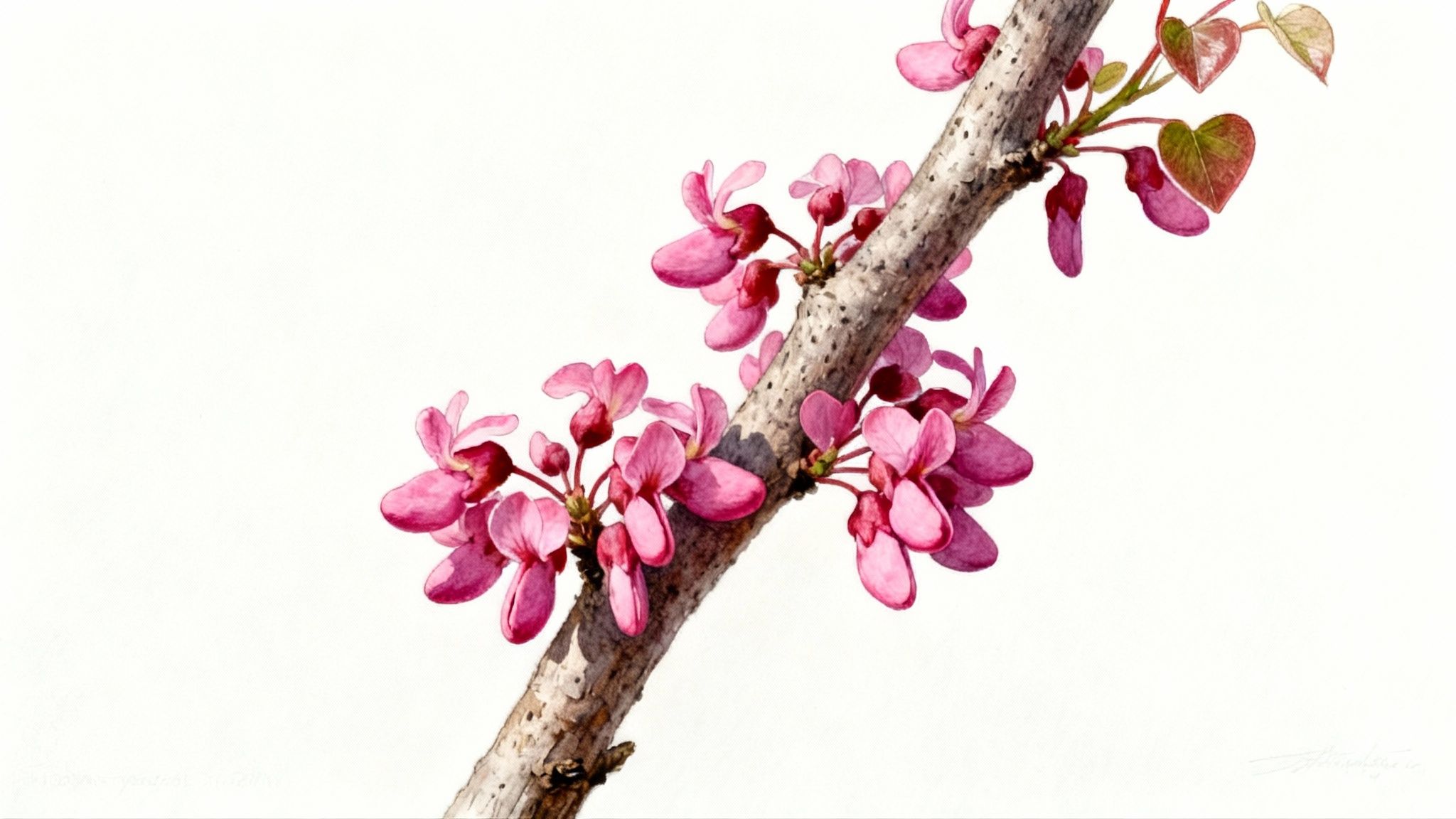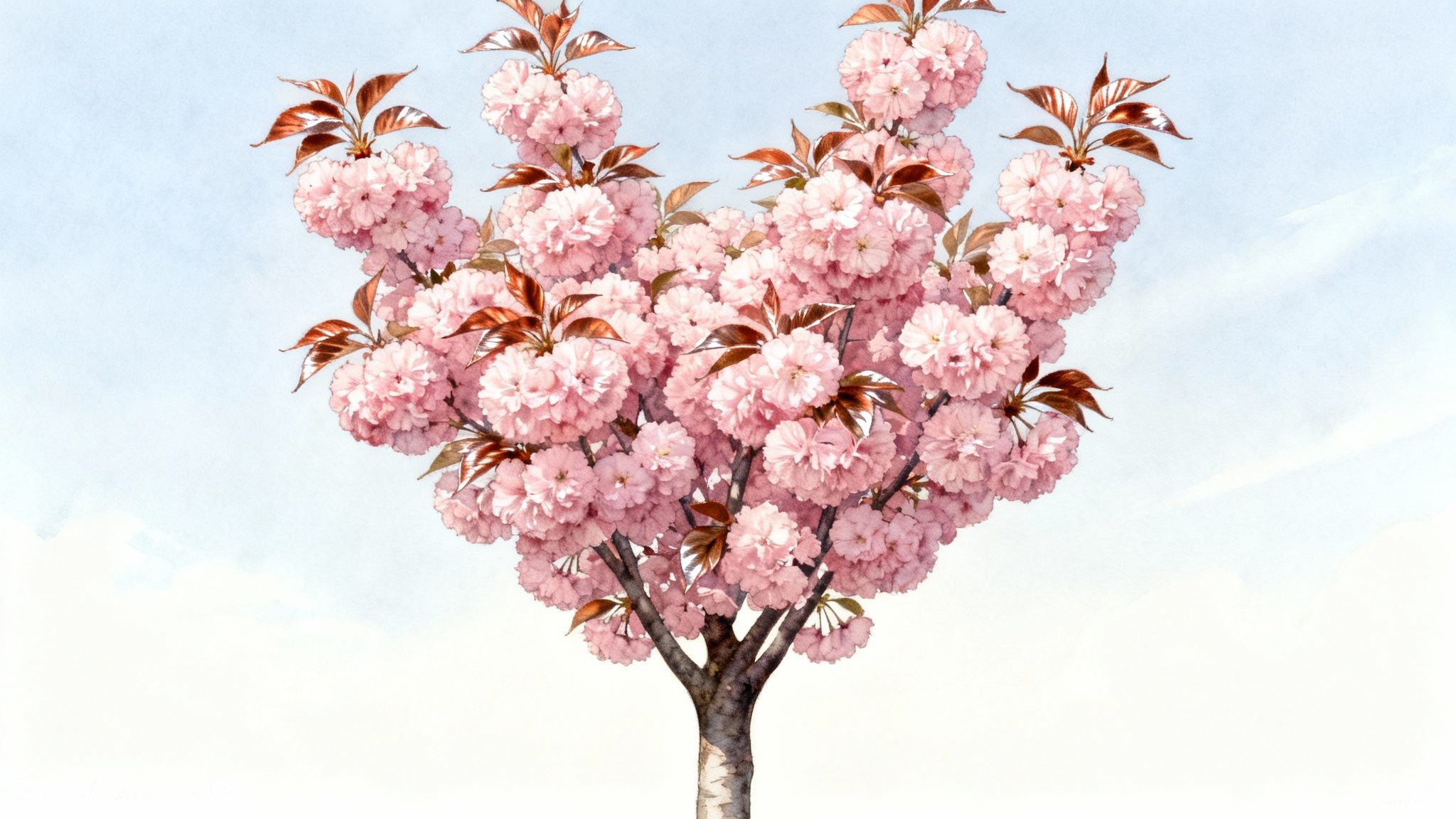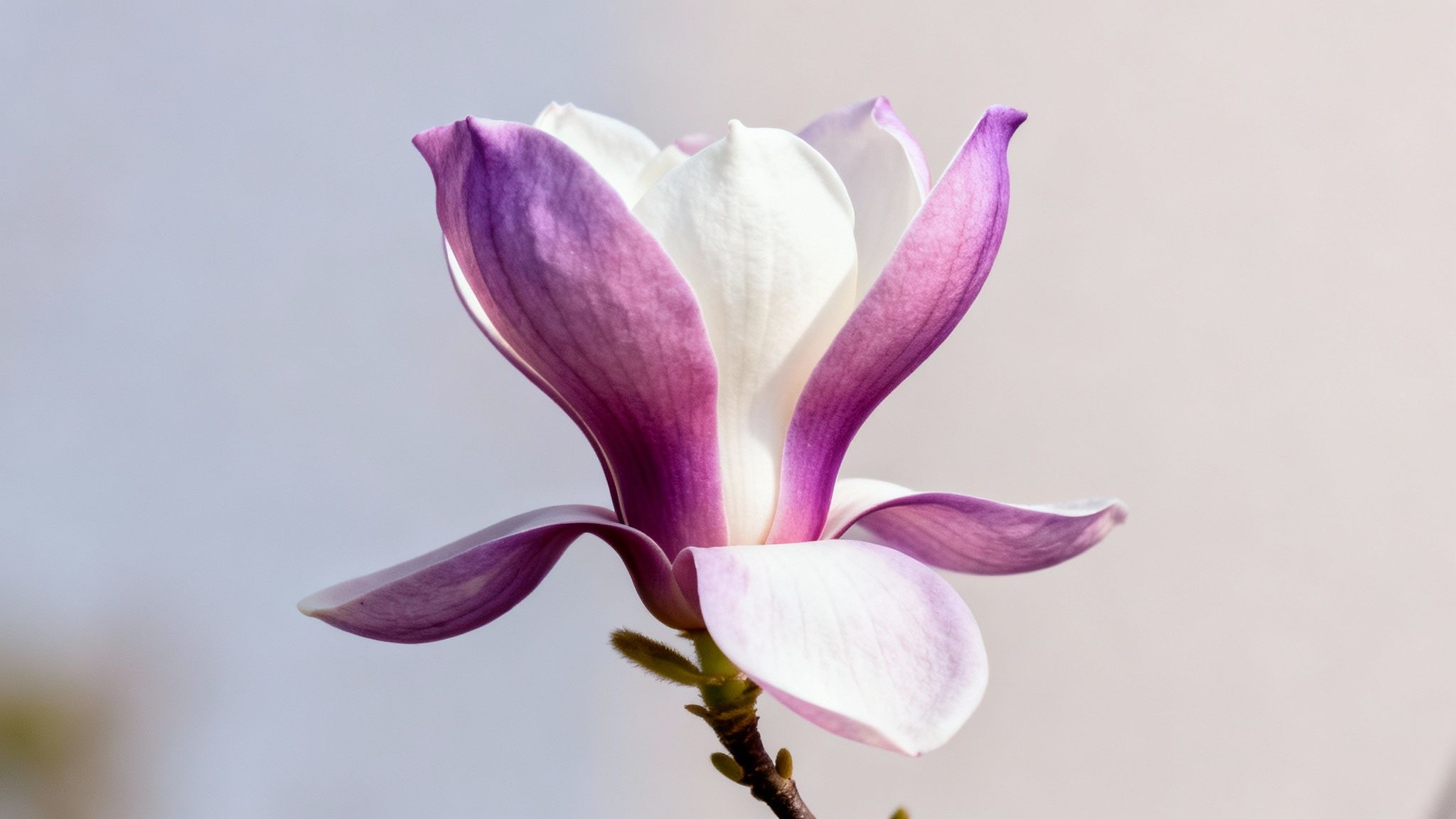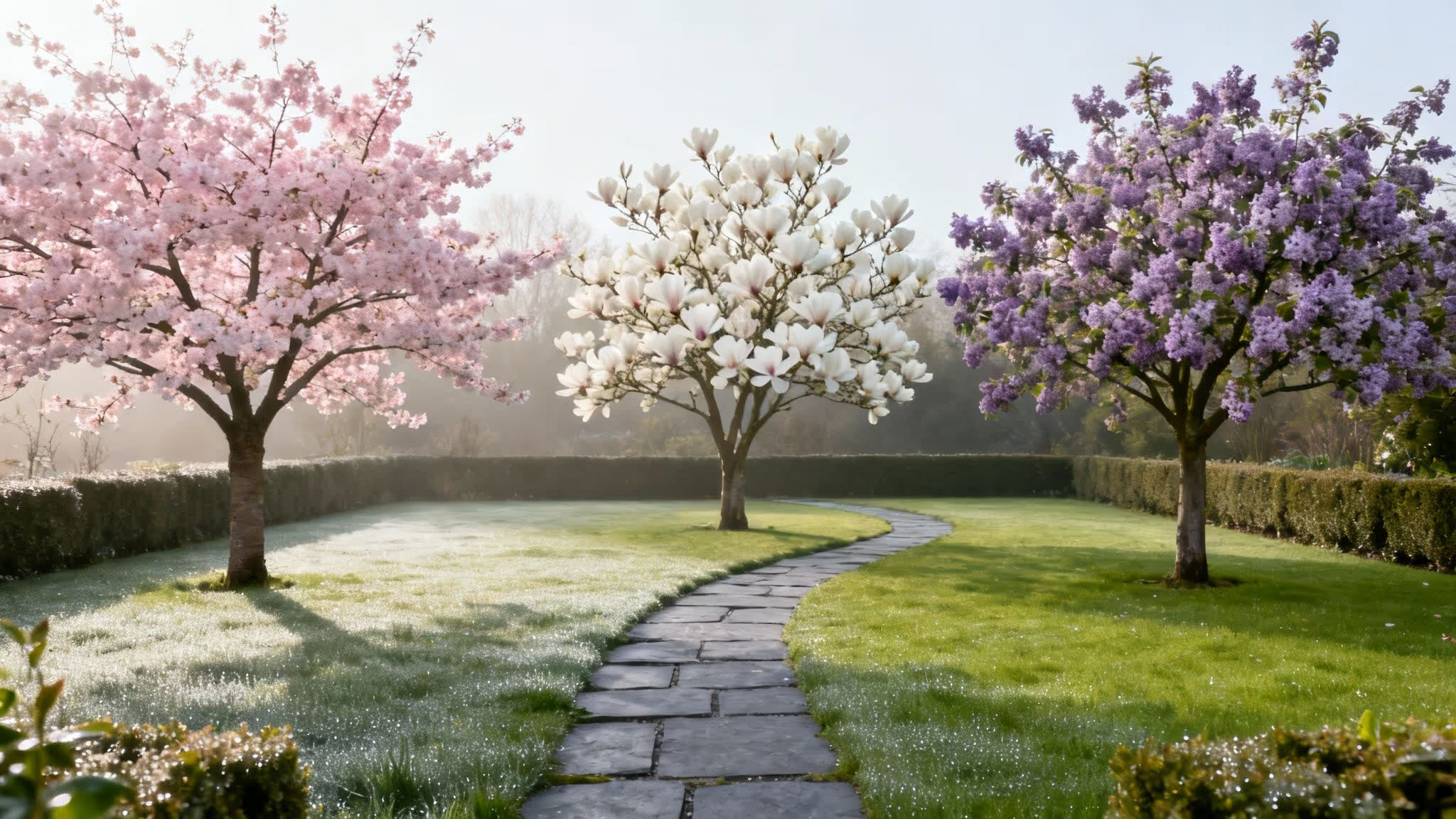As the chill of winter recedes, nothing signals the arrival of spring quite like the spectacular explosion of colour from a flowering tree. More than just plants, these are living sculptures that become the centrepiece of any garden, offering blossoms that delight the senses, support crucial pollinators, and promise warmer days ahead. Choosing the right tree can feel like a significant decision, but it's a rewarding investment in your garden's long-term beauty and character.
This guide has been carefully curated to simplify that choice for UK gardens. We will showcase 10 exceptional springtime flowering trees, from compact weeping varieties perfect for patios to magnificent specimens suited for larger lawns. For each tree, you will find practical, actionable advice on planting, ongoing care, and clever design integration. Our goal is to provide clear, straightforward information, helping you select the perfect tree to transform your outdoor space into a breathtaking spring sanctuary. We'll explore the unique attributes of varieties like the elegant Dogwood and the prolific Crabapple, ensuring you have the knowledge to make a confident choice. Let’s explore the trees that will bring your garden to life this season.
1. Yoshino Cherry (Prunus × yedoensis)
The Yoshino Cherry is arguably one of the most iconic springtime flowering trees, celebrated worldwide for its breathtaking floral displays. This Japanese hybrid creates a spectacular, ethereal effect in early spring when its branches become completely engulfed in clouds of delicate, almond-scented blossoms. The five-petaled flowers, which range from a soft pale pink to pure white, emerge before the leaves, ensuring an unobstructed and truly dramatic canopy. This fleeting, yet magnificent, display typically lasts for around two weeks, making it a highly anticipated garden event.

This tree's global fame is well-deserved; it is the star of the National Cherry Blossom Festival in Washington D.C. and creates the iconic cherry-lined Philosopher's Path in Kyoto, Japan. Its graceful, spreading habit makes it an excellent choice for a specimen tree in a lawn or as the centrepiece of a Japanese-inspired garden design.
Planting and Care Tips
To ensure your Yoshino Cherry thrives and produces the best possible bloom, follow these key practices:
- Site Selection: Choose a location that receives at least six hours of direct sunlight per day. Good air circulation is also beneficial.
- Soil Requirements: The tree prefers moist, fertile, and well-draining soil. It is adaptable but will struggle in waterlogged or extremely dry conditions.
- Planting Time: For best results in the UK, plant your bare-root or container-grown tree in the autumn. This allows the root system to establish over the winter, reducing transplant shock in spring.
- Watering: Water newly planted trees regularly during their first two years, especially during dry spells, to help them establish a strong root system.
- Pruning: Yoshino cherries require minimal pruning. Simply remove any dead, damaged, or crossing branches in late spring after the flowering period has finished.
2. Eastern Redbud (Cercis canadensis)
The Eastern Redbud is a delightful addition to any garden, offering one of the first and most vibrant displays among springtime flowering trees. This elegant, often multi-stemmed tree puts on a truly unique show in early spring. Before its distinctive heart-shaped leaves appear, its bare, dark branches and even the main trunk become covered in clusters of tiny, brilliant magenta-pink flowers. This unusual trait, known as cauliflory, creates a stunning visual effect that is both delicate and dramatic.

Native to North America, this adaptable tree is celebrated in gardens like the Missouri Botanical Garden for its multi-season interest and value to wildlife. Its smaller stature makes it perfect for understory planting, adding a splash of intense colour beneath larger deciduous trees, or as a standalone specimen in smaller UK gardens where space is a premium. The foliage that follows the flowers provides a lovely, dense canopy through summer before turning a beautiful buttery yellow in autumn.
Planting and Care Tips
To get the most from your Eastern Redbud and its spectacular spring bloom, consider these key care points:
- Site Selection: Plant in a spot with full sun to partial shade. In warmer parts of the UK, a position with morning sun and some afternoon shade is ideal to protect the foliage.
- Soil Requirements: It thrives in moist, well-draining soil but is quite adaptable. It will not perform well in permanently wet or waterlogged conditions.
- Planting Time: Autumn is the optimal time for planting in the UK, as it allows the tree to establish its roots over winter. For more detailed timings, you can use our UK planting calendar to guide you.
- Watering: Water new trees deeply and regularly for the first couple of years. Once established, they are reasonably drought-tolerant but benefit from watering during prolonged dry periods.
- Pruning: Little to no pruning is required. Simply remove any dead, damaged, or poorly-placed branches after the flowering season has ended to maintain its attractive natural shape.
3. Kwanzan Cherry (Prunus serrulata 'Kanzan')
The Kwanzan Cherry, often called 'Kanzan', is one of the most flamboyant and popular springtime flowering trees, renowned for its exceptionally showy display. Unlike its single-petaled relatives, the Kwanzan produces large, double pompom-like flowers, each containing 20-30 ruffled, deep pink petals. These stunning blossoms appear in dense clusters in mid to late spring, creating a breathtaking spectacle that is both vibrant and long-lasting. The new foliage emerges with a distinctive bronze-red colour, providing a beautiful contrast to the bright pink flowers.

This tree's upright, vase-shaped form makes it an excellent choice for avenues, street plantings, and as a standout specimen tree in gardens of all sizes. Its robust and spectacular nature has led to its prominent use in world-famous displays, such as the Brooklyn Botanic Garden's Cherry Walk and the vast collection at Branch Brook Park in New Jersey. The sheer intensity of its bloom ensures it makes a powerful statement in any landscape design.
Planting and Care Tips
To get the most from your Kwanzan Cherry and ensure a healthy, vigorous tree, consider these essential care tips:
- Site Selection: Plant in a location that receives full sun (at least six hours daily). Good air circulation is vital to help prevent fungal diseases.
- Soil Requirements: It thrives in fertile, moist, and well-draining soil. It's important to amend heavy clay soils to improve drainage before planting.
- Planting Time: Autumn is the ideal time to plant in the UK, allowing the roots to establish before the growing season begins in spring.
- Watering: Water newly planted trees regularly and deeply, especially during their first few years and in periods of drought, to encourage a strong root system.
- Pruning: The Kwanzan requires minimal pruning. If needed, remove any dead, damaged, or poorly placed branches in late spring, immediately after it has finished flowering.
4. Dogwood (Cornus florida)
The Flowering Dogwood is a truly elegant addition to any garden, offering year-round interest and making it one of the most cherished springtime flowering trees. In mid-spring, its graceful, tiered branches are adorned with unique and showy "flowers". These are actually modified leaves called bracts, which can be brilliant white, soft pink, or even reddish, surrounding the true, inconspicuous greenish-yellow flowers at the centre. This distinctive display creates a breathtaking, layered effect, often before the tree fully leafs out.

While native to North America, where it's celebrated in places like the U.S. National Arboretum, the Dogwood has found a welcome home in many UK gardens. Its architectural, horizontal branching structure provides superb visual appeal even in winter. Beyond its spring bloom, it produces glossy red berries that attract birds in late summer and boasts spectacular scarlet and purple foliage in autumn, ensuring it remains a garden focal point through multiple seasons. It's a great choice for woodland settings, mixed borders, or as a standalone specimen tree, reflecting the growing trend for multi-seasonal planting designs. You can find more inspiration for your outdoor space by exploring the latest UK garden trends for 2025.
Planting and Care Tips
To cultivate a healthy and beautiful Flowering Dogwood, pay close attention to its specific needs:
- Site Selection: Plant in a spot with dappled sunlight or partial shade, ideally with protection from hot afternoon sun which can scorch the leaves.
- Soil Requirements: It thrives in acidic, fertile, and well-draining soil that is rich in organic matter. Avoid planting in waterlogged or very dry, sandy soils.
- Mulching: Apply a generous 3-4 inch layer of organic mulch around the base to keep the soil cool and moist, mimicking its natural woodland habitat.
- Watering: Water newly planted trees deeply and consistently, especially during prolonged dry periods, to help establish a robust root system.
- Pest and Disease: To prevent borer infestations, avoid damaging the trunk with lawnmowers or strimmers. Ensure good air circulation around the tree to reduce the risk of fungal diseases like anthracnose. Choosing disease-resistant cultivars is also a wise strategy.
5. Saucer Magnolia (Magnolia × soulangeana)
The Saucer Magnolia is a classic and much-loved harbinger of spring, renowned for its large, dramatic flowers that appear before the leaves. As one of the most popular springtime flowering trees, this hybrid produces spectacular goblet-shaped blooms that can reach an impressive 10 inches across. The petals create a beautiful two-toned effect, typically showcasing a rich purple-pink on the outside and a pristine white interior, offering a truly magnificent sight in the early-season garden.
This deciduous tree's breathtaking display makes it a firm favourite in temperate gardens worldwide, from the historic collections at the Royal Botanic Gardens, Kew, to countless residential gardens across the UK. Its elegant, often multi-stemmed form and early bloom time make it an outstanding specimen tree, providing a powerful focal point against a backdrop of evergreen shrubs or a dark-coloured wall.
Planting and Care Tips
To get the most from your Saucer Magnolia, consider these essential care points:
- Site Selection: Plant in a spot sheltered from strong winds and late spring frosts, which can damage the flowers. An eastern or northern-facing position can help delay flowering slightly, offering more protection from frost.
- Soil Requirements: It thrives in moist, slightly acidic, and well-draining soil that has been enriched with plenty of organic matter.
- Planting Time: Autumn is the ideal time to plant in the UK. This gives the root system time to establish before the growing season begins.
- Watering: Young trees need consistent watering, especially during dry periods. Applying a generous layer of mulch will help keep the roots cool and retain soil moisture.
- Pruning: Magnolias generally dislike pruning. Only remove dead, damaged, or poorly placed branches immediately after the flowering period to avoid disrupting the next year's bloom.
6. Crabapple (Malus species and cultivars)
Flowering crabapples are some of the most versatile and rewarding springtime flowering trees, valued for their four-season interest. In spring, they erupt in a profusion of fragrant blossoms, with colours ranging from pure white and soft pink to deep magenta and vibrant red. Unlike many other flowering trees whose beauty is fleeting, the crabapple’s display is followed by small, decorative fruits that persist into winter, providing a crucial food source for birds and adding a splash of colour to the stark winter landscape.
With hundreds of modern, disease-resistant cultivars available, these trees are adaptable to almost any garden size, from compact, shrubby forms perfect for small spaces to larger, spreading trees ideal as a lawn centrepiece. They are a common feature in public spaces like the Royal Botanic Gardens, Kew, and are frequently used as resilient street trees across the UK due to their reliability and ornamental value. Their hardy nature makes them a dependable choice for almost any British garden.
Planting and Care Tips
To get the most from your crabapple tree and ensure a healthy, stunning display, consider these key care points:
- Site Selection: Plant in a location that receives full sun, meaning at least six to eight hours of direct sunlight daily, to promote the best flowering and fruit production.
- Disease Resistance: Prioritise modern cultivars bred for resistance to common issues like scab and fire blight. Look for varieties with an RHS Award of Garden Merit (AGM) as a reliable indicator of performance.
- Soil and Airflow: While adaptable, crabapples perform best in well-drained, fertile soil. Good air circulation around the tree is vital to minimise the risk of fungal diseases.
- Pruning: Pruning is best done in late winter while the tree is dormant to shape it and remove any dead, damaged, or crossing branches. For detailed guidance, learn more about the best time to prune fruit trees.
- Watering: Water newly planted trees regularly during their first couple of seasons to help establish a deep and robust root system, especially during prolonged dry periods.
7. Serviceberry/Amelanchier (Amelanchier species)
The Serviceberry is an elegant and versatile choice among springtime flowering trees, valued for its delicate beauty and exceptional four-season interest. Often known as Juneberry or Shadbush, this understated tree puts on a charming display in early spring when its bare branches are covered in masses of star-shaped, pure white flowers. These blossoms appear in loose, slightly drooping clusters just before or as the leaves emerge, creating a soft, ethereal cloud in the landscape. The display is a vital early food source for pollinators.
Beyond its spring flowers, the Serviceberry provides year-round appeal; it produces edible, blueberry-like fruits in summer, boasts fiery red and orange foliage in autumn, and reveals a smooth, grey, and sculptural bark structure in winter. Its multi-season performance and value to wildlife make it an excellent, sustainable choice for naturalistic plantings and smaller urban gardens. Its slender form makes it a great candidate for inclusion in mixed plantings; you can learn more about creating stunning displays with our garden border plant ideas.
Planting and Care Tips
To help your Serviceberry establish well and reward you for years to come, consider these key points:
- Site Selection: Plant in a location with full sun to partial shade. Unlike many flowering trees, it tolerates dappled shade quite well.
- Soil Requirements: It thrives in moist, well-draining, acidic soil but is adaptable to a range of soil types, except for very wet or very dry conditions.
- Planting Time: Autumn is the ideal time to plant in the UK, allowing the roots to establish before the growing season begins.
- Watering: Provide consistent moisture, especially during its first few years. A layer of mulch around the base will help retain soil moisture.
- Pruning: Serviceberries require very little pruning. If you prefer a single-trunk tree form, simply remove any suckers that grow from the base. Otherwise, only prune to remove dead or damaged wood after flowering.
8. Japanese Flowering Cherry 'Snow Fountains' (Prunus × 'Snofozam')
The Japanese Flowering Cherry 'Snow Fountains' is one of the most graceful and elegant springtime flowering trees, renowned for its unique weeping form. In early spring, its pendulous branches are completely smothered in masses of pure white, single flowers, creating a breathtaking cascade of blossom that resembles a fountain of snow. This display appears before the leaves, allowing the floral show to take centre stage. Its compact, weeping habit makes it a perfect choice for smaller gardens or even large containers.
This distinctive tree is a stunning focal point, with branches that sweep downwards, often reaching the ground. 'Snow Fountains' is frequently featured in contemporary and Japanese-inspired garden designs, where its architectural form provides year-round interest. Its manageable size also makes it a popular choice as a specimen tree for front gardens in suburban developments, offering high impact without overwhelming the space. In autumn, the green foliage turns attractive shades of orange and red.
Planting and Care Tips
To get the most out of your 'Snow Fountains' cherry and ensure a spectacular bloom, consider these key points:
- Site Selection: Plant in a location that receives full sun to encourage the most prolific flowering.
- Soil Requirements: It thrives in fertile, moist, and well-draining soil. Amending heavy clay soils with organic matter will improve its performance.
- Planting Time: Autumn is the ideal time to plant in the UK. This gives the tree the winter months to establish its root system before the growing season begins.
- Watering: Ensure newly planted trees are watered regularly, particularly during their first two years and through any dry periods, to establish a strong foundation.
- Pruning: This variety requires very little pruning. Allow the branches to cascade naturally and only remove any dead, damaged, or crossing stems after it has finished flowering in late spring.
9. Tulip Tree/Tulip Poplar (Liriodendron tulipifera)
The Tulip Tree is a truly magnificent and stately addition to the list of springtime flowering trees, valued for its grand scale and unique blossoms. A fast-growing giant native to North America, it produces striking, upright, tulip-shaped flowers in late spring. These captivating blooms are a subtle yellow-green with a vibrant orange band at the base, although they often appear high in the canopy, offering a delightful surprise from an upper-storey window. The tree's distinctively shaped, four-lobed leaves add to its appeal, turning a brilliant buttery yellow in autumn.
This tree's imposing stature makes it unsuitable for small gardens; it is a true parkland or estate tree, perfect for spacious properties where it can reach its full potential. Its columnar form and rapid growth make it an excellent choice for providing substantial shade and creating a dramatic landscape feature. Historically, it has been planted on grand estates, such as George Washington's Mount Vernon, and in arboretums across the UK.
Planting and Care Tips
To cultivate a healthy and impressive Tulip Tree, consider these essential guidelines:
- Site Selection: This tree is for large spaces only. Plant it in a location that receives full sun and is well away from buildings, utility lines, and paving.
- Soil Requirements: It thrives in deep, moist, well-drained, and slightly acidic soil. It does not tolerate prolonged drought or waterlogged conditions.
- Planting Time: Plant young, container-grown trees in autumn to allow the roots to establish before the growing season. Avoid trying to transplant larger specimens, as they do not respond well.
- Watering: Ensure the tree is watered consistently during its first few years, particularly through dry periods, to support its rapid growth.
- Pruning: The Tulip Tree has a naturally strong structure and requires very little pruning. Remove any dead, damaged, or poorly positioned branches in late winter while the tree is dormant.
10. Hawthorn (Crataegus species)
The Hawthorn is a quintessential feature of the British countryside and a wonderfully tough and versatile choice among springtime flowering trees. These small, often thorny trees are celebrated for their profusion of fragrant, clustered blossoms that appear in May, typically in shades of crisp white or soft pink. The dense, twiggy structure becomes a blanket of flowers, creating a stunning display that is highly attractive to bees and other pollinators. This spring spectacle is followed by deep green, lobed leaves.
Long valued for its role in traditional English hedgerows, the hawthorn offers fantastic four-season interest. After flowering, it produces bright red berries known as 'haws' in autumn, which provide a vital food source for birds like thrushes and waxwings through the winter. Its hardy nature makes it a superb selection for wildlife gardens, native planting schemes, or as a resilient, low-maintenance specimen tree in a smaller garden.
Planting and Care Tips
To get the most from your Hawthorn tree and ensure a healthy, vibrant display, consider these key points:
- Site Selection: Plant in a full sun position for the best flowering and fruiting performance. Good air circulation is also important to minimise the risk of fungal diseases like leaf spot.
- Soil Requirements: Hawthorns are exceptionally adaptable and will tolerate a wide range of soil types, including clay and alkaline conditions, but they perform best in well-drained soil.
- Planting Time: Autumn is the ideal time to plant bare-root or container-grown hawthorns in the UK. This gives the roots ample time to establish before the growing season begins.
- Watering: Water young trees regularly during their first couple of years, particularly through dry periods, until they are well-established.
- Pruning: Prune in late winter or early spring while the tree is dormant. Remove any dead, damaged, or crossing branches to maintain an open framework. Always wear heavy-duty gloves to protect against the sharp thorns.
Springtime Flowering Trees Comparison
Your Blooming Garden Awaits
Choosing from the UK's spectacular array of springtime flowering trees is more than a simple gardening task; it's an investment in your home's future and a commitment to creating a living legacy. From the clouds of ethereal white blossoms on a Yoshino Cherry to the majestic, goblet-shaped flowers of a Saucer Magnolia, each tree we've explored brings its own unique character and seasonal drama to the landscape. We've journeyed through the delicate charm of the Eastern Redbud, the four-season interest of the Serviceberry, and the rugged, wildlife-friendly nature of the Hawthorn, providing a blueprint for gardens of every size and style.
The key takeaway is that the perfect tree is a harmonious match between your garden's specific conditions and your personal aesthetic vision. A successful display hinges on understanding your soil type, available sunlight, and the ultimate mature size of your chosen specimen. Remember, the initial effort invested in proper site preparation, planting technique, and early watering is the most critical step towards ensuring decades of breathtaking spring displays.
Your Action Plan for a Flourishing Garden
To turn inspiration into reality, here are your immediate next steps:
- Assess Your Space: Before heading to the nursery, take precise measurements of your intended planting area. Note the hours of direct sunlight it receives daily and perform a simple soil pH test. This foundational knowledge will narrow your choices and prevent future disappointment.
- Match Tree to Purpose: Are you seeking a dramatic focal point like a Kwanzan Cherry, a screen for privacy, or a smaller, multi-stemmed tree like an Amelanchier for a compact space? Define the tree's role in your garden design.
- Review and Select: Revisit the trees on our list. Cross-reference their specific needs (soil, light, moisture) with your garden's profile. Select your top two or three candidates that are a strong match.
- Source with Care: Visit a reputable local nursery or specialist online supplier. Inspect the tree for signs of good health, such as a strong central leader (where applicable), healthy-looking bark, and a well-formed root system. Ask staff for advice on the best cultivars for our UK climate.
Expert Insight: The most beautiful gardens are not created by chance. They are the result of thoughtful planning that considers the entire life cycle of a plant. Selecting the right tree for the right place is the cornerstone of sustainable and rewarding garden design.
Embracing one of these magnificent springtime flowering trees will transform your outdoor space, providing not just seasonal colour but also shade, structure, and a vital habitat for local wildlife. It becomes a landmark for your family, a backdrop for memories, and a source of profound, simple joy each time it bursts into bloom. Your journey to a more beautiful, vibrant garden starts now.




